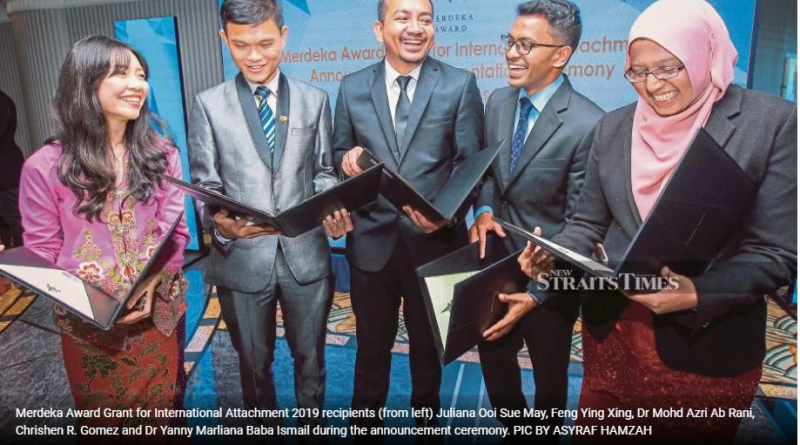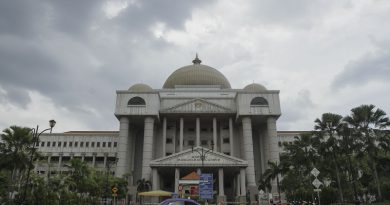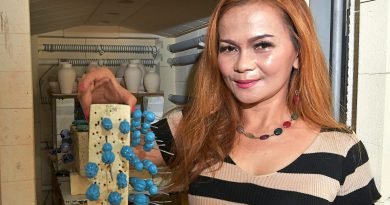Five young Msians win Merdeka Award Grant
OUR journey to the Merdeka Award Grant for International Attachment 2019WHAT do sheet batteries, Sunda clouded leopards, chronic stress and Functional Near-Infrared Spectroscopy (fNIRS) brain signals, synthetic ceramic “bone” material, as well as teenage pregnancies and baby dumping have in common?
These are the research subjects that won the five of us the Merdeka Award Grant for International Attachment 2019.
We are humbled and thrilled to receive the award grant from His Royal Highness Sultan Nazrin Muizzuddin Shah, Royal Patron of the Merdeka Award Trust.
We are proud to be part of the 19 recipients between the ages of 22 and 35, since its inception in 2012 aimed at building Malaysian capacity at the world’s leading institutions.
On ceremony day, we amused ourselves with the thought of finally having the opportunity to refer to ourselves officially as “Patik”, leveraging off the many years of Bahasa Malaysia lessons on the royal linguistic etiquette!
In fact, arriving at this day has been nothing short of a journey in itself.
We have spent years dedicating our lives inside science labs, in the community, and even lived in the jungle, all for the Malaysian Dream to which we hold dearly.
Two months before being finalised as winners, we were given the opportunity by the Merdeka Award Grant for International Attachment Board of Trustees and Secretariat to attend a “Masterclass on Storytelling for Pitching Success” facilitated by Ramli Atan, Leadership Development Learning specialist at the Petronas Leadership Centre, as part of our preparation to pitch for our research and project ideas the week after.
We came with an open mind, but with slight anxiety from the discomfort of this unfamiliar territory.
As young researchers and social innovators, pitching and storytelling rarely take centre stage in our work. There were 21 finalists, all talented and enthusiastic young scientists, film-makers, linguists, educators and environmentalists. Little did we know, this workshop would completely transform our approach to communication and make us understand its importance.
When we were asked to pitch our story, like touch-me-nots, we almost instantly closed our leaves!
We recalled some amusing incidents that happened during the pitching workshop, but they were also impactful because we were given the platform to grow and learn from our imperfections in pitching for our ideas through feedback from our dear teach-ers, Ramli, Alicia Ahmad Zubeir and Raja Idzam Raja Mohamed. A shout-out to Nadia Shaik Izuddin too, for the flawless coordination and support.
Well, we were all nervous, except for Chrishen the “Leopard” boy, who was the most eloquent among us. He shared that he and his team aspires to unweave the web of genetic stories behind Malaysia’s very own Sunda clouded leopard against the effect of development as part of the conservation work they are doing in Tawau, Sabah.
Then came Feng, who reduced the tension in the room by cracking a joke. He asked for a show of hands among those feeling “stressed”, and all 21 participants did and laughed together. He aims to seek biomarkers that could help identify the nature of stress from fNIRS brain signals as an early preventive measure for costly mental illnesses, and subsequently, improve cognitive performance.
Conversely, Juliana who was shy, froze on the tenth-second into her practice pitch, but completed it with the warm encouragement from the rest of us. She aspires to design a culturally sensitive and age-appropriate toolkit in Reproductive and Social Health and support young parents in creating a safe and comfortable space at home as a strategy to help their children learn protective life skills.
Next, Dr Yanny, the most cheerful among us, brought our imaginations into the sombre trauma room with bloodied accident victims and broken bones. She leads a research to produce a synthetic ceramic material that, when combined with collagen, mimics our native bone composition and architecture, and can speed up new bone growth. As it can be fabricated in-house, it is a potentially affordable option for patients from the bottom billion.
Finally, Dr Azri, normally quiet and composed, became animated when explaining his on-going research of a sheet battery type that is 200 times cheaper, greener and lighter by using the analogy of a piece of paper and a bottle of water.
Why should young researchers also be storytellers?
Simply because “facts tell, but stories sell”, especially in an era where we compete to communicate evidence and key findings of our work out of the academic world.
One cannot believe in an idea simply by thinking it is good. He has to feel it, too.
Moreover, research has shown that our brains are hardwired to remember stories. In this workshop, we have learnt about setting up “hooks”, connecting the problem with emotional dissonance, providing or proposing solutions concisely, and connecting the research to a larger perspective of contribution to the world.
We were also taught the science of effective communication through body language, hand gestures, voice and tones and non-verbal cues.
In fact, our entire approach to our careers shifted when we started looking at them through the lens of a storyteller.
We were forced to reimagine our respective fields of expertise and understand how to relate it to public sentiment.
Firstly, in order to tell stories, we learnt to identify with our emotions and feelings and that of others.
Secondly, to be concise in storytelling, we were prompted to conscientiously examine our work in the larger context of the country and the world.
Thirdly, while telling stories, we started to evaluate ourselves on the lessons learnt or best practices, even failure and frustration, as part of the storyline.
Finally, we reviewed our ethical standards and stand on issues, as we learn to tell meaningful and compassionate stories without dramatising, stigmatising or exaggerating the details.
Eventually, these stories will travel to different parts of the world as we proceed with our international attachments and they collectively define who we are, five young Malaysians, with the same Malaysian Dream — to build a better nation.
As we celebrate our 62nd Merdeka, let us heed the advice of Sultan Nazrin Muizzuddin Shah, in his keynote speech during the Merdeka Award Grant for International Attachment 2019 Presentation.
He said as the world was undergoing a transformation, the country should move forward from the laurels of its past successes to the next phase of its journey towards a sustainable future.
Finally, we would like to take this opportunity to thank the founding members of the Merdeka Award Trust; Petronas, ExxonMobil Malaysia, Shell Malaysia, members of the Selection Committee and Secretariat, our parents, families, mentors, teachers, friends and pets!
Source: NST




